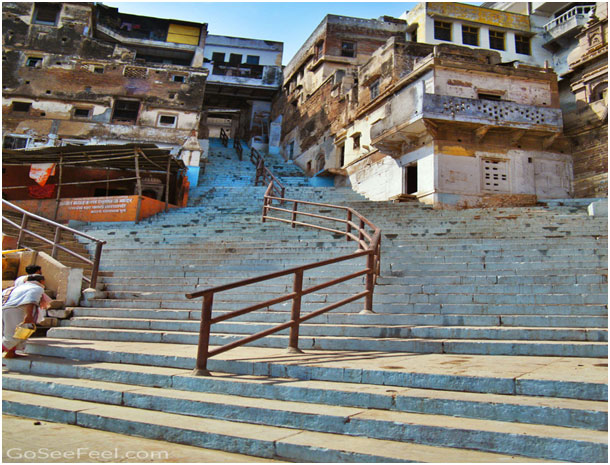Adapted from Shri Chaitanya Charitamrita Madhya lila chapter 16 onwards:
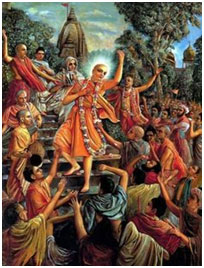 When Sri Caitanya Mahäprabhu wanted to go to Vrndavana, Ramananda Raya and Sarvabhauma Bhattacarya indirectly presented many obstructions. In due course of time, all the devotees of Bengal visited Jagannatha Puri for the third year. This time, all the wives of the Vaisnavas brought many types of food, intending to extend invitations to Sri Caitanya Mahaprabhu at Jagannatha Puri. When the devotees arrived, Caitanya Mahaprabhu sent His blessings in the form of garlands. In that year also, the Gundica temple was cleansed, and when the Caturmasya period was over, all the devotees returned to their homes in Bengal. Caitanya Mahaprabhu forbade Nityananda to visit Nilacala every year. Questioned by the inhabitants of Kulina-grama, Caitanya Mahaprabhu again repeated the symptoms of a Vaisnava. Vidyanidhi also came to Jagannatha Puri and saw the festival of Odana-sasthi. When the devotees bade farewell to the Lord, the Lord was determined to go to Vrindavana, and on the day of Vijaya-dasami, He departed.
When Sri Caitanya Mahäprabhu wanted to go to Vrndavana, Ramananda Raya and Sarvabhauma Bhattacarya indirectly presented many obstructions. In due course of time, all the devotees of Bengal visited Jagannatha Puri for the third year. This time, all the wives of the Vaisnavas brought many types of food, intending to extend invitations to Sri Caitanya Mahaprabhu at Jagannatha Puri. When the devotees arrived, Caitanya Mahaprabhu sent His blessings in the form of garlands. In that year also, the Gundica temple was cleansed, and when the Caturmasya period was over, all the devotees returned to their homes in Bengal. Caitanya Mahaprabhu forbade Nityananda to visit Nilacala every year. Questioned by the inhabitants of Kulina-grama, Caitanya Mahaprabhu again repeated the symptoms of a Vaisnava. Vidyanidhi also came to Jagannatha Puri and saw the festival of Odana-sasthi. When the devotees bade farewell to the Lord, the Lord was determined to go to Vrindavana, and on the day of Vijaya-dasami, He departed.
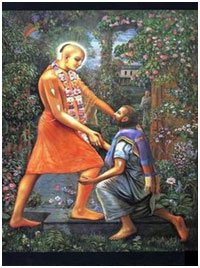
Maharaja Prataparudra made various arrangements for Sri Caitanya Mahaprabhu’s trip to Vrndavana. When He crossed the river Citrotpala, Rämananda Raya, Mardaraja and Haricandana went with Him. Sri Caitanya Mahäprabhu requested Gadadhara Pandita to return to Nilacala, Jagannatha Puri, but he did not abide by this order. From Kataka, Sri Caitanya Mahäprabhu again requested Gadädhara Pandita to return to Nilacala, and He bade farewell to Ramananda Raya from Bhadraka. After this, Sri Caitanya Mahäprabhu crossed the border of Orissa state, and He arrived at Pänihäti by boat. Thereafter, He visited the house of Räghava Pandita, and from there He went to Kumarahatta and eventually to Kuliyä, where He excused many offenders. From there, He went to Rämakeli, where He saw Sri Rüpa and Sanätana and accepted them as His chief disciples. Returning from Rämakeli, He met Raghunätha däsa and after giving him instructions sent him back home. Thereafter the Lord returned to Nilacala and began to make plans to go to Vrndavana without a companion.
After attending the Ratha-yäträ ceremony of Sri Jagannatha, Sri Caitanya Mahäprabhu decided to start for Vrndavana. Sri Rämänanda Räya and Svarüpa Dämodara Gosvämi selected a brähmana named Balabhadra Bhattäcärya to personally assist Sri Caitanya Mahäprabhu. Early in the morning before sunrise, the Lord started for the town of Kataka. To the north of Kataka, He penetrated a dense forest and came upon many tigers and elephants, whom He engaged in chanting the Hare Krsna mahä-mantra. Whenever the Lord had a chance to visit a village, Balabhadra Bhattäcärya would beg alms and acquire some rice and vegetables. If there were no village, Balabhadra would cook whatever rice remained and collect some spinach from the forest for the Lord to eat. Sri Caitanya Mahäprabhu was very pleased with the behavior of Balabhadra Bhattäcärya.
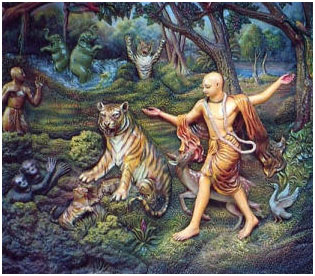
In this way the Lord passed through the jungle of Jharikhanda and finally reached Varanasi. After taking His bath at the Manikarnika-ghata at Varanasi, He met Tapana Misra, who took the Lord to his place and respectfully gave Him a comfortable residence. At Varanasi, Vaidya Candrasekhara, Sri Caitanya Mahaprabhu’s old friend, also rendered service unto Him. Seeing the behaviour of Sri Caitanya Mahäprabhu, a Maharashtrian brahmana informed Prakasananda Sarasvati, the leader of the Mayavadi sannysis. Prakasananda made various accusations against the Lord. The Maharashtrian brahmana was very sorry about this, and he brought the news to Sri Caitanya Mahäprabhu, inquiring from Him why the Mayavadi sannyasis did not utter the holy name of Krsna. In reply, Sri Caitanya Mahäprabhu said that they were offenders and that one should not associate with them. In this way the Lord bestowed His blessings upon the brahmana.
Sri Caitanya Mahaprabhu next passed through Prayaga and Mathura and then took His lunch at the home of a Sänodiyä brähmana, a disciple of Mädhavendra Puri. He bestowed His blessings upon the brähmana by accepting lunch at his place. Thereafter the Lord visited the twelve forests of Vrndävana and was filled with great ecstatic love.
Meanwhile meeting Sri Caitanya Mahäprabhu in a village called Rämakeli, two brothers, Rüpa and Sanätana, began to devise means to get out of their government service. They appointed some brähmanas to perform purascarana ceremonies and chant the holy name of Krsna. Srila Rüpa Gosvämi deposited ten thousand gold coins with a grocer, and the balance he brought in two boats to a place called Bäklä Candradvipa. There he divided this money among the brähmanas, Vaisnavas and his relatives, and a portion he kept for emergency measures and personal needs. He was informed that Sri Caitanya Mahäprabhu was going to Vrndävana from Jagannätha Puri through the forest of Madhya Pradesh; therefore he sent two people to Jagannätha Puri to find out when the Lord would leave for Vrndävana. In this way Rüpa Gosvämi retired, but Sanätana Gosvämi told the Nawab that he was sick and could not attend to his work. Giving this excuse, he sat at home and studied Srimad-Bhagavatam with learned brähmana scholars. The Nawab Hussain Shah first sent his personal physician to see what the real facts were; then he personally came to see why Sanatana was not attending to official business. Knowing that he wanted to resign his post, the Nawab had him arrested and imprisoned. The Nawab then went off to attack Orissa.
When Sri Caitanya Mahäprabhu started for Vrndavana through the forest of Madhya Pradesh (Jharikhanda), Rüpa Gosvami left home and sent news to Sanätana that he was leaving with his younger brother (Anupama Mallika) to meet Sri Caitanya Mahäprabhu. Srila Rüpa Gosvami finally reached Prayaga and met with Sri Caitanya Mahäprabhu for ten successive days.
When Srila Sanätana Gosvami was imprisoned by Nawab Hussain Shah, he received news from Rüpa Gosvami that Sri Caitanya Mahäprabhu had gone to Mathurä. Sanätana Gosvämi thereafter satisfied the superintendent of the jail by sweet solicitations and bribery. After giving the jailer seven thousand gold coins, Sanätana Gosvämi was released. He then crossed the Ganges and fled. One of his servants, Isana, followed him, carrying eight gold coins. Sanätana Gosvämi and his servant then spent the night in a small hotel on the way to Varanasi (Benares). The hotel owner knew that Sanätana Gosvämi and his servant had eight gold coins, and he decided to kill them and take the money. Making plans in this way, the hotel owner received them as honorable guests. Sanätana Gosvämi, however, asked his servant how much money he had, and taking the seven gold coins, Sanätana offered them to the hotel owner. Thus the owner helped them cross the hilly tract and proceed toward Väränasi. On the way, Sanätana Gosvämi met his brother-in-law, Srikänta, at Häjipura, and Srikänta helped him after he had heard about all Sanatana’s troubles. Thus Sanätana Gosvami finally arrived at Väränasi and stood before the door of Candrasekhara.
Caitanya Mahäprabhu called him in and ordered him to change his dress so that he would look like a gentleman. For his garment, he used an old cloth of Tapana Misra’s. Later, he exchanged his valuable blanket for a torn quilt. At this time Caitanya Mahäprabhu was very pleased with him, and thus Sri Sanätana Gosvämi received knowledge of the Absolute Truth from the Lord Himself.
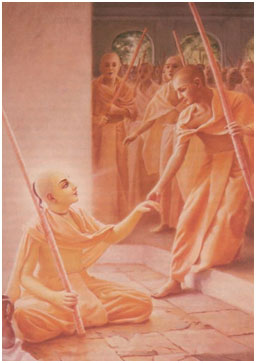
First they discussed the constitutional position of the living entities, and Sri Caitanya Mahäprabhu explained to Sanätana Gosvämi how the living entity is one of Lord Krsna’s energies. After this, the Lord explained the way of devotional service. While discussing the Absolute Truth, Sri Krsna, and the Lord analyzed Brahman, Paramätmä and Bhagavän, as well as the expansions of the Lord called svayam-rupa, tad-ekätma and ävesa, which are divided into various branches known as vaibhava and präbhava. Thus the Lord described the many forms of the Supreme Personality of Godhead. He also described the incarnations of God within the material world, incarnations such as the purusa-avatäras, manvantara-avatäras, guna-avatäras and saktyävesa-avatäras. The Lord also discussed the divisions of Krsna’s different ages, such as bälya and pauganda, and the different pastimes of the different ages. He explained how Krsna attained His permanent form when He reached youth. In this way Sri Caitanya Mahäprabhu explained and described everything to Sanätana Gosvämi.
In this way Sri Caitanya Mahäprabhu blessed Sanätana Gosvämi, placing His hand on his head. Thus Sanätana received the power to describe these subjects in books like Hari-bhakti-viläsa.
A Maharashtrian brähmana who was living in Benares was a great devotee of Sri Caitanya Mahäprabhu. He was always very happy to hear the glories of the Lord, and it was by his arrangement that all the sannyäsis of Väränasi became devotees of Lord Caitanya Mahäprabhu.
He invited all the sannyäsis to his house to meet Sri Caitanya Mahäprabhu, and this incident has been described in the seventh chapter of Ädi-lilä. From that day, Sri Caitanya Mahäprabhu became famous in the city of Varanasi, and many important men in that city became His followers. By and by, one of the disciples of the great sannyäsi Prakasananda Sarasvati became devoted to Sri Caitanya Mahäprabhu, and this devotee explained Sri Caitanya Mahäprabhu to Prakäsänanda Sarasvati and supported His views with various arguments.
One day Sri Caitanya Mahäprabhu went to take a bath at Pancanada, and afterwards all His devotees began chanting the Hare Krsna mantra in front of the temple of Bindu Mädhava. At this time, Prakäsänanda Sarasvati and all his devotees approached the Lord. Prakäsänanda Sarasvati immediately fell down at the lotus feet of Sri Caitanya Mahäprabhu and very much regretted his past behaviour toward the Lord. He asked Sri Caitanya Mahäprabhu about devotional service in terms of the Vedänta-sütra, and the Lord told him about devotional service that is approved by great personalities who know the Vedänta-sütra. Sri Caitanya Mahäprabhu then pointed out that Srimad-Bhägavatam is the proper commentary on the Vedänta-sütra. He then explained the catur-sloki [SB 2.9.33/34/35/36] (four slokas) of Srimad-Bhägavatam, the essence of that great scripture.
From that day on, all the sannyäsis of Väränasi became devotees of Sri Caitanya Mahäprabhu. Before returning to His headquarters at Jagannätha Puri, the Lord advised Sanätana Gosvämi to go to Vrndavana. The Lord then departed for Jagannätha Puri.
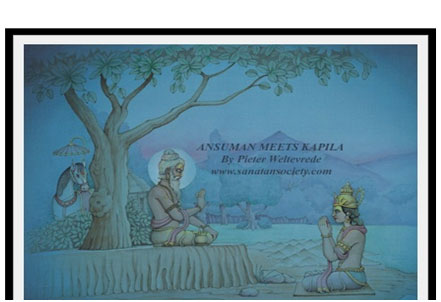 Once Koshala was a great kingdom and king Sagara was performing Ashwamedha Yagna. He lost the track of his sacrificial horse. He sent his 60 thousand sons to find the horse. They searched horse in every corner of earth & destroyed everything that came in their path. At last they reached to sage Kapila asharam and they saw the horse was tied. They made charges on the sage of stealing the horse. As a result of this offense to sage Kapila, all sixty thousand sons were burned to ashes. King Sagara waiting for his sons then sent his grandson Anshuman. Kapila said to him that only by the presence of sacred river Ganga, all sixty thousand sons will be purified and delivered.
Once Koshala was a great kingdom and king Sagara was performing Ashwamedha Yagna. He lost the track of his sacrificial horse. He sent his 60 thousand sons to find the horse. They searched horse in every corner of earth & destroyed everything that came in their path. At last they reached to sage Kapila asharam and they saw the horse was tied. They made charges on the sage of stealing the horse. As a result of this offense to sage Kapila, all sixty thousand sons were burned to ashes. King Sagara waiting for his sons then sent his grandson Anshuman. Kapila said to him that only by the presence of sacred river Ganga, all sixty thousand sons will be purified and delivered. As time passed, their curse multiplied and it started to even destroy the Koshala kingdom. And then king Bhagirathi spur into action and did penance for 1000 years & pleased Lord Brahma to send Ganga on earth. Now the force of river was so destructive that earth will not be able to hold it. For that Brahma told Bhagirathi to pray to Lord Shiva. After a year of penance Lord Shiva appeared & told Bhagirathi that his wish would be fulfilled. When Ganga was falling from heaven, everybody was so afraid that everything would be destroyed. Ganga came forcefully. As it was going to hit the earth Lord Shiva captured her in his jata (matted hair). Ganga was helpless and was unable to come out of it. At this Bhagirathi prayed Shiva again & Lord Shiva released Ganga.
As time passed, their curse multiplied and it started to even destroy the Koshala kingdom. And then king Bhagirathi spur into action and did penance for 1000 years & pleased Lord Brahma to send Ganga on earth. Now the force of river was so destructive that earth will not be able to hold it. For that Brahma told Bhagirathi to pray to Lord Shiva. After a year of penance Lord Shiva appeared & told Bhagirathi that his wish would be fulfilled. When Ganga was falling from heaven, everybody was so afraid that everything would be destroyed. Ganga came forcefully. As it was going to hit the earth Lord Shiva captured her in his jata (matted hair). Ganga was helpless and was unable to come out of it. At this Bhagirathi prayed Shiva again & Lord Shiva released Ganga.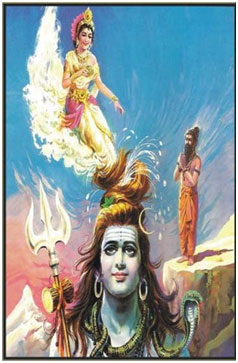

 Thus Lord Vishnu caused the departure of King Divodasa and gave Varanasi back to Lord Shiva. Lord Vishnu and Shiva, along with other demigods and goddesses, have manifested themselves here in many ways ever since. You can find all varieties of temples dedicated to many personalities. Thus, they say that all the gods reside here. And it is said that all of the holy places of India can be found in certain portions of the town. Mathura is found in one part of the town, Ayodhya in another, as well as Badrinatha, Dwaraka, and so on. In fact, some of the ancient texts say that Varanasi is not of this earth, but is a holy place and part of the spiritual realm. Therefore, dying in this city brings salvation from future material existence. So there is a strong atmosphere of devotion here as many pilgrims come from all over to spend their last days living in this city, bathing in the sacred Ganges, visiting temples, and having darshan of the deities, all for spiritual purification.
Thus Lord Vishnu caused the departure of King Divodasa and gave Varanasi back to Lord Shiva. Lord Vishnu and Shiva, along with other demigods and goddesses, have manifested themselves here in many ways ever since. You can find all varieties of temples dedicated to many personalities. Thus, they say that all the gods reside here. And it is said that all of the holy places of India can be found in certain portions of the town. Mathura is found in one part of the town, Ayodhya in another, as well as Badrinatha, Dwaraka, and so on. In fact, some of the ancient texts say that Varanasi is not of this earth, but is a holy place and part of the spiritual realm. Therefore, dying in this city brings salvation from future material existence. So there is a strong atmosphere of devotion here as many pilgrims come from all over to spend their last days living in this city, bathing in the sacred Ganges, visiting temples, and having darshan of the deities, all for spiritual purification. When Sri Caitanya Mahäprabhu wanted to go to Vrndavana, Ramananda Raya and Sarvabhauma Bhattacarya indirectly presented many obstructions. In due course of time, all the devotees of Bengal visited Jagannatha Puri for the third year. This time, all the wives of the Vaisnavas brought many types of food, intending to extend invitations to Sri Caitanya Mahaprabhu at Jagannatha Puri. When the devotees arrived, Caitanya Mahaprabhu sent His blessings in the form of garlands. In that year also, the Gundica temple was cleansed, and when the Caturmasya period was over, all the devotees returned to their homes in Bengal. Caitanya Mahaprabhu forbade Nityananda to visit Nilacala every year. Questioned by the inhabitants of Kulina-grama, Caitanya Mahaprabhu again repeated the symptoms of a Vaisnava. Vidyanidhi also came to Jagannatha Puri and saw the festival of Odana-sasthi. When the devotees bade farewell to the Lord, the Lord was determined to go to Vrindavana, and on the day of Vijaya-dasami, He departed.
When Sri Caitanya Mahäprabhu wanted to go to Vrndavana, Ramananda Raya and Sarvabhauma Bhattacarya indirectly presented many obstructions. In due course of time, all the devotees of Bengal visited Jagannatha Puri for the third year. This time, all the wives of the Vaisnavas brought many types of food, intending to extend invitations to Sri Caitanya Mahaprabhu at Jagannatha Puri. When the devotees arrived, Caitanya Mahaprabhu sent His blessings in the form of garlands. In that year also, the Gundica temple was cleansed, and when the Caturmasya period was over, all the devotees returned to their homes in Bengal. Caitanya Mahaprabhu forbade Nityananda to visit Nilacala every year. Questioned by the inhabitants of Kulina-grama, Caitanya Mahaprabhu again repeated the symptoms of a Vaisnava. Vidyanidhi also came to Jagannatha Puri and saw the festival of Odana-sasthi. When the devotees bade farewell to the Lord, the Lord was determined to go to Vrindavana, and on the day of Vijaya-dasami, He departed.


